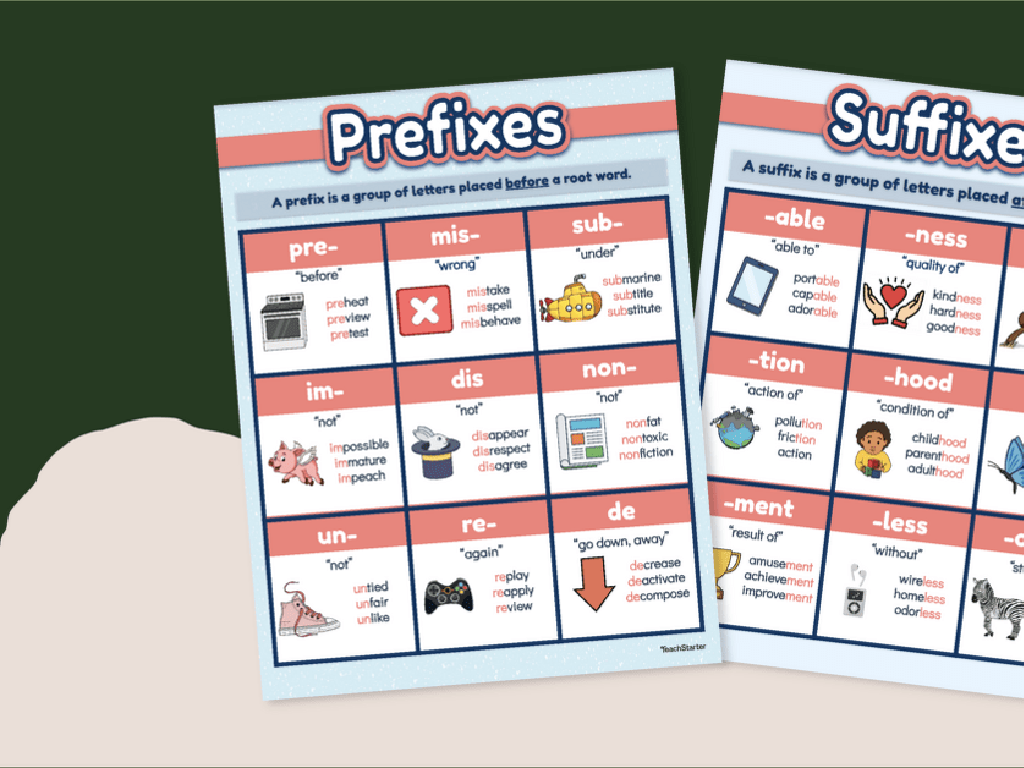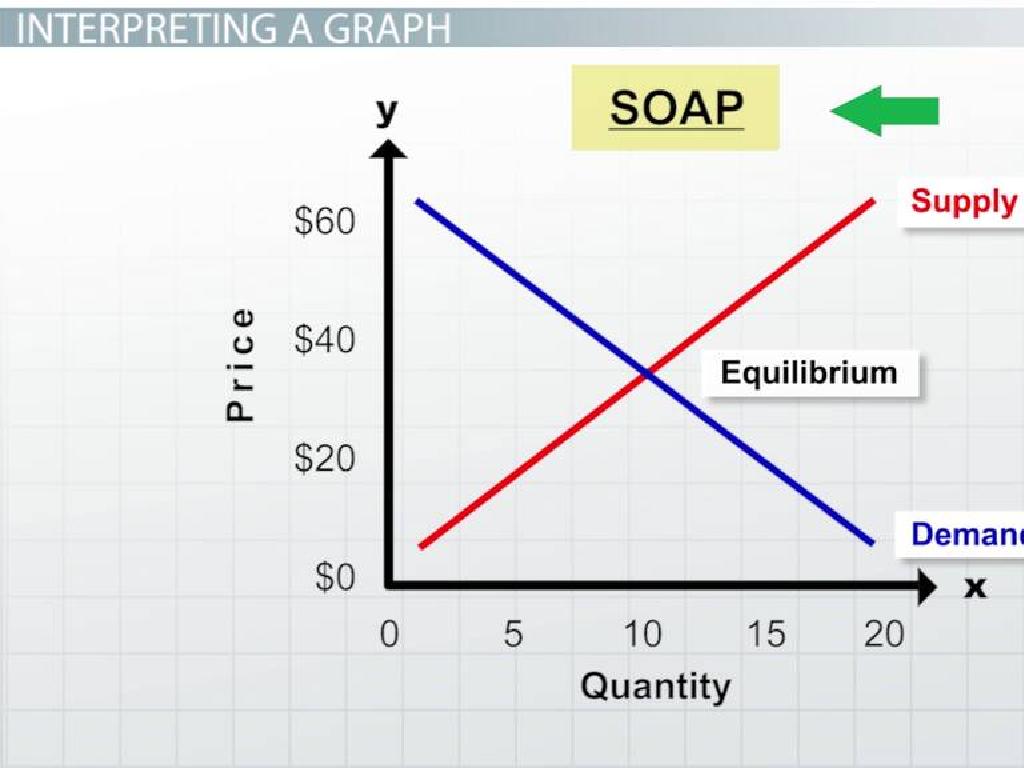Form And Use Plurals: Review
Subject: Language arts
Grade: Seventh grade
Topic: Nouns
Please LOG IN to download the presentation. Access is available to registered users only.
View More Content
Nouns and Their Plurals
– Welcome to Language Arts class
– Nouns: Words that name people, places, things, or ideas
– Examples: ‘dog’, ‘school’, ‘happiness’
– Plurals: When we have more than one
– Add ‘s’ or ‘es’, change ‘y’ to ‘ies’, or irregular forms
– Understanding plurals is crucial for proper grammar
– Helps in writing and speaking correctly
|
Today’s class is an exciting journey into the world of nouns and their plurals. Begin with a warm welcome and explain that nouns are the building blocks of language, naming everything around us. Emphasize the importance of plurals as they help us to communicate accurately about quantity. Discuss the basic rules for forming plurals, such as adding ‘s’ or ‘es’, and the exceptions like changing ‘y’ to ‘ies’ for words ending in ‘y’. Highlight that mastering plurals is essential for students to write and speak correctly, and it’s a key component of their language arts education. Engage the class with examples and encourage them to think of their own. Prepare for interactive activities where students will practice forming and using plural nouns in sentences.
Understanding Plurals in Nouns
– Define plural nouns
– Plurals refer to more than one of something, like ‘dogs’ or ‘cars’.
– Singular vs. plural nouns
– Singular means one; plural means more than one. For example, ‘cat’ vs. ‘cats’.
– Transform singular to plural
– Add ‘s’ or ‘es’, change ‘y’ to ‘ies’, or irregular forms like ‘mouse’ to ‘mice’.
– Practice with examples
– ‘Box’ becomes ‘boxes’, ‘baby’ becomes ‘babies’, and ‘child’ becomes ‘children’.
|
This slide introduces the concept of plural nouns to the students. Start by defining what plural nouns are and how they differ from singular nouns. Emphasize the basic rules for transforming singular nouns into plural forms, such as adding ‘s’ or ‘es’, changing ‘y’ to ‘ies’, and noting irregular forms. Provide clear examples for each rule to ensure understanding. Encourage students to come up with their own examples and share them with the class. This will help reinforce their learning and provide an opportunity for peer learning.
Forming Regular Plural Nouns
– Add ‘s’ or ‘es’ for regular plurals
– Example: ‘cat’ becomes ‘cats’
– Example: ‘bus’ becomes ‘buses’
– Class practice with noun list
– Transform singular nouns to plurals as a class activity
|
This slide is focused on teaching students the basic rule for forming regular plurals in English, which is by adding ‘s’ or ‘es’ to the end of the singular noun. Use straightforward examples like ‘cat’ to ‘cats’ and ‘bus’ to ‘buses’ to illustrate the rule. During class practice, provide a diverse list of singular nouns for students to convert into plurals, ensuring a mix of nouns that require just ‘s’ and those that need ‘es’. This will help reinforce the concept and allow for immediate application of the rule. Encourage students to explain why they chose ‘s’ or ‘es’ for each word to deepen their understanding. The activity should be interactive and engaging, allowing students to learn from each other’s examples.
Irregular Plural Forms
– Understanding irregular plurals
– Not all plurals end with ‘s’ or ‘es’
– Examples: ‘child’ to ‘children’
– Singular ‘child’ changes to plural ‘children’
– ‘Mouse’ becomes ‘mice’
– Singular ‘mouse’ changes to plural ‘mice’
– Exceptions in plural rules
– Some nouns change vowels, others are unique
|
This slide introduces students to irregular plural forms, which are plurals that do not follow the standard ‘add s’ or ‘es’ rule. Provide examples like ‘child’ to ‘children’ and ‘mouse’ to ‘mice’ to illustrate the concept. Discuss how some words change their vowels when they become plural, while others have completely unique plural forms. Emphasize that these exceptions need to be memorized as they do not follow regular patterns. Encourage students to think of other examples and to understand that language can have special rules that must be learned.
Special Plural Cases in Nouns
– Irregular plural forms
– Not all nouns add ‘s’ or ‘es’ for plural form.
– Same singular and plural nouns
– Some nouns never change, like ‘sheep’ and ‘series’.
– Completely changed plurals
– Words like ‘man’ become ‘men’, altering entirely.
– Understanding exceptions
|
This slide addresses the irregularities in forming plurals in English. While most nouns follow the regular pattern of adding ‘s’ or ‘es’, there are exceptions that students must memorize. Some nouns have the same form for both singular and plural, such as ‘sheep’ and ‘series’, which can be confusing. Others change completely, such as ‘man’ to ‘men’. It’s important to provide students with a list of these irregular nouns and encourage them to practice using them in sentences. This will help them recognize and use these special cases correctly in their writing and speech.
Plurals Practice: Mastering Nouns
– Interactive plural conversion activity
– Identify correct plural forms
– For example, ‘child’ becomes ‘children’, not ‘childs’
– Discuss challenging plural words
– Words like ‘mouse’ to ‘mice’ can be tricky
– Clarify doubts about plurals
– Open discussion to address specific questions
|
This slide is designed for an interactive class activity focused on the practice of forming plural nouns. Start with an engaging activity where students convert singular nouns to their plural forms. Have a list of nouns ready for students to work on, including both regular and irregular nouns. Encourage students to identify the correct plural forms and write them down. After the activity, discuss any nouns that were particularly challenging and clarify common doubts, such as irregular plural forms or nouns that don’t follow standard rules. Use this opportunity to reinforce the lesson and ensure students feel confident in their understanding of plural nouns.
Plurals in Sentences
– Rules for using plural nouns
– Add ‘s’ or ‘es’, change ‘y’ to ‘ies’, or irregular forms
– Correct examples in sentences
– ‘Dogs bark loudly.’ ‘Children play games.’
– Class activity: crafting sentences
– Create sentences with plural nouns you’ve learned
– Share and discuss with the class
|
This slide aims to reinforce the rules for forming and using plural nouns within the context of sentences. Start by reviewing the basic rules for making nouns plural, including when to simply add ‘s’ or ‘es’, change ‘y’ to ‘ies’, and the irregular forms that don’t follow standard rules. Provide clear examples of sentences that use plural nouns correctly. For the class activity, have students come up with their own sentences using plural nouns they’ve recently learned or from a provided list. Encourage creativity and proper usage. After the activity, students should share their sentences with the class, allowing for a discussion on the correct formation and use of plural nouns. This will help solidify their understanding and give them practical experience in constructing sentences with plural nouns.
Class Activity: Plural Scavenger Hunt
– Pair up for a classroom scavenger hunt
– List items in singular and plural forms
– For example, ‘book’ becomes ‘books’, but ‘child’ becomes ‘children’
– Share findings with the class
– Discuss irregular plural forms
– Highlight words like ‘mouse’ to ‘mice’ and ‘cactus’ to ‘cacti’
|
This interactive activity is designed to help students recognize and form regular and irregular plural nouns. Students will work in pairs to foster collaboration. They will search for various items in the classroom and write down both the singular and plural forms, which will help them understand the rules and patterns in a fun and engaging way. After the hunt, each pair will share their list with the class, providing an opportunity for discussion, especially focusing on any irregular plural forms they encountered. The teacher should prepare to guide the discussion and clarify any misconceptions. Possible variations of the activity could include using classroom objects, words from a book, or pictures from a magazine.
Review and Quick Quiz: Plurals
– Recap on forming plurals
– Reviewed rules for regular and irregular plurals
– Quick quiz on plural nouns
– Test your knowledge with a few questions
– Homework: 10 sentences with plurals
– Use various plural nouns in creative sentences
– Share and discuss answers
|
As we close today’s lesson, let’s review the key points on forming plurals. Remember, most nouns simply add ‘s’ or ‘es’, but watch out for those irregular forms that completely change. We’ll have a quick quiz to test your understanding of these rules. For homework, write 10 sentences using different plural nouns to demonstrate your grasp of the concept. Be creative and try to use a mix of regular and irregular plural forms. In our next class, we’ll share some of these sentences and discuss any questions you may have encountered while completing your assignment.






